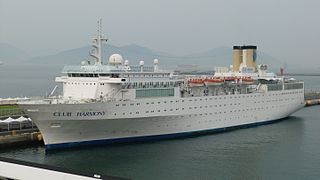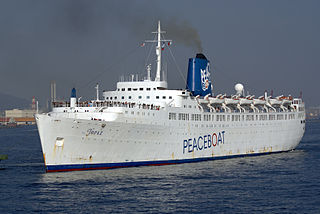The Wigham Richardson shipbuilding company was named after its founder, John Wigham Richardson (1837-1908), the son of Edward Richardson, a tanner from Newcastle upon Tyne, and Jane Wigham from Edinburgh.

The MS Costa Marina was a cruise ship, last owned by Polaris Shipping and operated by Harmony Cruises.

RMS Empress of Britain was a transatlantic ocean liner built by Fairfield Shipbuilding at Govan on the Clyde in Scotland in 1955-1956 for Canadian Pacific Steamships (CP). This ship — the third of three CP vessels to be named Empress of Britain — regularly traversed the trans-Atlantic route between Canada and Europe until 1964, completing 123 voyages under the Canadian Pacific flag.

MS Stockholm was the name of two near-identical ocean liners built by Cantieri Riuniti dell' Adriatico, Monfalcone, Italy between 1936 and 1941 for the Swedish American Line. Neither of the ships entered service for the company that had ordered them—the first ship was entirely destroyed by fire during construction in 1938, while the second was completed in 1941 but immediately sold to the Italian government as a troopship. The second ship served for three years in the Regia Marina and Kriegsmarine under the name MS Sabaudia, until sunk by British bombers outside Trieste in 1944. It is unknown if she was ever actually used as a troopship.

The Type C4-class ship were the largest cargo ships built by the United States Maritime Commission (MARCOM) during World War II. The design was originally developed for the American-Hawaiian Lines in 1941, but in late 1941 the plans were taken over by the MARCOM.

MS Golden Princess was a casino cruise ship owned by Eurasia International, operated on short casino cruises out of Hong Kong. She was built in 1967 by the Wärtsilä Hietalahti shipyard in Helsinki, Finland as Finlandia for the Finland Steamship Company. In 1975 she was sold to Finnlines, who converted her into the cruise ship Finnstar in 1978. In 1982 she entered service for Pearl Cruises as Pearl of Scandinavia. In 1988 she was renamed Ocean Pearl. In 1994 she entered service with Croisières Paquet as Pearl. Between 1995 and 1998 she sailed for Costa Cruises as Costa Playa. In 1998-1999 she sailed as Oriental Pearl for Mega Wave International, and in 1999-2000 as Joy Wave for Costa Cruises. In 2000 she was sold to Eurasia International and entered service under the name Golden Princess. In 2009 she was sold for scrap to China.
SS Culross was a 7,331 ton cargo ship which was built as Empire Antigua in 1945. She was renamed Culross in 1946. In 1960 she was renamed Akastos, serving under a number of flags until 1968 when she was renamed Marina, being scrapped in that year.
Counties Ship Management Co. Ltd. (CSM) was an ocean-going merchant shipping company based in the United Kingdom. During the Second World War CSM merchant ships made a substantial contribution to supplying the British war effort, at a cost of 13 ships lost and 163 officers and men killed.

Maudie was a 4,661 GRT tanker that was built in 1920 by Lithgows, Port Glasgow, Scotland. Laid down as War Peshwa for the British Shipping Controller, she was completed as Maudie for a Norwegian company. In 1937, she was sold to Finland and renamed Angra. A further sale in 1942 saw her renamed Mercator.

The SS Cody Victory was a Victory ship (VC2-S-AP3) built during World War II under the Emergency Shipbuilding program. The ship's keel was laid by the California Shipbuilding Company as hull number 69 on 26 October 1944 with launch on 12 December 1944. The ship was completed on 22 January 1945. On completion the ship, U.S. Official Number 247094, was delivered to the War Shipping Administration for operation by the Alcoa Steamship Company as agent.

The Type R ship is a United States Maritime Administration (MARAD) designation for World War II refrigerated cargo ship, also called a reefer ship. The R type ship was used in World War II, Korean War, Vietnam War and the Cold War. Type R ships were used to transport perishable commodities which require temperature-controlled transportation, such as fruit, meat, fish, vegetables, dairy products and other foods. The US Maritime Commission ordered 41 new refrigerated ships for the US Navy. Because of the difficulty of building refrigerated ships only two were delivered in 1944, and just 26 were delivered in 1945 and the remainder in 1946–48. The 41 R type ships were built in four groups. Two of design types were modified type C1 ships and two were modified type C2 ships. The United Fruit Company operated many of the R type ships in World War II. The type R2-S-BV1 became the US Navy Alstede-class stores ship and the type R1-M-AV3 became the US Navy Adria-class stores ship.
Khalda was a Hansa A Type cargo ship which was built as Tiefland in 1943 by Lübecker Flenderwerke AG, Lübeck, Germany for Hamburg Südamerikanische Dampfschifffahrts-Gesellschaft A/S & Co K, Hamburg. She was seized as a prize of war in 1945, passing to the British Ministry of War Transport and renamed Empire Gatehouse. She was sold to Canada in 1947 and was renamed Gulfport. She was sold to Liberia in 1964 and was renamed Stefani, then Agia Marina in 1966. She was sold to Greece in 1967 and renamed Bright. Sold in 1969 to Panama and renamed Khalda, she was arrested in 1974. Sold to Ethiopia in 1977, she was scrapped in 1982.

A. H. Bull Steamship Company was a shipping company and passenger liner service founded in New York City in 1902 by Archibald H. Bull (1848-1920). Service started with shipping between New York and Florida. His fleet of ships then added service to other Eastcoast ports. The company is also often called the Bull Lines and the Bull Steamship Line or A. H. Bull & Company. While founded in New York, Bull soon move its headquarter to Peir 5 in Baltimore, Maryland. Bull Lines main Eastcoast ports were: Baltimore, Charleston, Philadelphia, Tampa and Norfolk, Virginia. Oversea ports: Porto Rico, Antwerp, Bordeaux, Hamburg, Bremen, Copenhagen, and West Africa. Bull Steamship Line supported the US war effort for both World War I and World War II, including the loss of ships.









